

Automated ‘coach’ could help with social interactions. Social phobias affect about 15 million adults in the United States, according to the National Institute of Mental Health, and surveys show that public speaking is high on the list of such phobias.

For some people, these fears of social situations can be especially acute: For example, individuals with Asperger’s syndrome often have difficulty making eye contact and reacting appropriately to social cues. But with appropriate training, such difficulties can often be overcome. Now, new software developed at MIT can be used to help people practice their interpersonal skills until they feel more comfortable with situations such as a job interview or a first date.
The software, called MACH (short for My Automated Conversation coacH), uses a computer-generated onscreen face, along with facial, speech, and behavior analysis and synthesis software, to simulate face-to-face conversations. THE WORLD QUESTION CENTER 2011— Page 14. HAZEL ROSE MARKUS & ALANA CONNER Hazel Rose Markus is the Davis-Brack Professor of Behavioral Sciences at Stanford University.

Co-author of Doing Race: 21 essays for the 21st century - Alana Conner is a science writer, cultural psychologist, and museum curator, The Tech Museum, San Jose, Calif. The Culture Cycle Pundits now invoke culture to explain all manner of tragedies and triumphs, from why a disturbed young man opens fire on a politician, to why African-American children struggle in school, to why the United States can't establish democracy in Iraq, to why Asian factories build better cars. A quick click through a single morning's media, for example, yields the following catch: gun culture, Twitter culture, ethical culture, Arizona culture, always-on culture, winner-take-all culture, culture of violence, culture of fear, culture of sustainability, culture of corporate greed.
Special issue on mindfulness neuroscience. Spiral of silence. The spiral of silence is a political science and mass communication theory propounded by the German political scientist Elisabeth Noelle-Neumann.
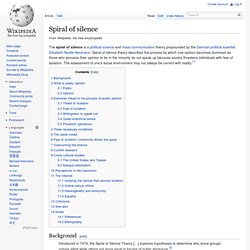
Spiral of silence theory describes the process by which one opinion becomes dominant as those who perceive their opinion to be in the minority do not speak up because society threatens individuals with fear of isolation. The assessment of one's social environment may not always be correct with reality. Background[edit] How To Say "No!" to Almost Anything [Epipheo.TV] Portal:Thinking. Primary consciousness. Qualia. In philosophy, qualia (/ˈkwɑːliə/ or /ˈkweɪliə/; singular form: quale) are what some consider to be individual instances of subjective, conscious experience.
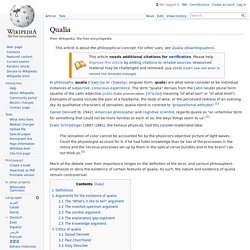
The term "qualia" derives from the Latin neuter plural form (qualia) of the Latin adjective quālis (Latin pronunciation: [ˈkʷaːlɪs]) meaning "of what sort" or "of what kind"). Examples of qualia include the pain of a headache, the taste of wine, or the perceived redness of an evening sky. Secondary consciousness. Secondary consciousness is an individual's accessibility to their history and plans.
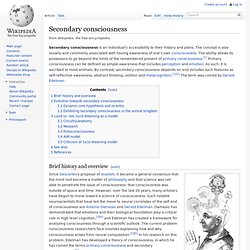
The concept is also loosely and commonly associated with having awareness of one's own consciousness. The ability allows its possessors to go beyond the limits of the remembered present of primary consciousness.[1] Primary consciousness can be defined as simple awareness that includes perception and emotion. As such, it is ascribed to most animals. By contrast, secondary consciousness depends on and includes such features as self-reflective awareness, abstract thinking, volition and metacognition.[1][2] The term was coined by Gerald Edelman. Brief history and overview[edit] Representation of consciousness from the seventeenth century. Evolution towards secondary consciousness[edit] Edelman argues that the evolutionary emergence of consciousness depended on the natural selection of neural systems that gave rise to consciousness, but not on selection for consciousness itself. Dynamic core hypothesis. Self-awareness. Self-awareness is the capacity for introspection and the ability to recognize oneself as an individual separate from the environment and other individuals.[1] It is not to be confused with consciousness.
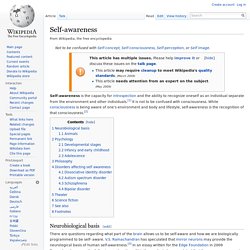
While consciousness is being aware of one’s environment and body and lifestyle, self-awareness is the recognition of that consciousness.[2] Neurobiological basis[edit] Emotion and memory. Emotion can have a powerful impact on memory.

Numerous studies have shown that the most vivid autobiographical memories tend to be of emotional events, which are likely to be recalled more often and with more clarity and detail than neutral events. The activity of emotionally enhanced memory retention can be linked to human evolution; during early development, responsive behavior to environmental events would have progressed as a process of trial and error. Survival depended on behavioral patterns that were repeated or reinforced through life and death situations. Through evolution, this process of learning became genetically embedded in humans and all animal species in what is known as flight or fight instinct. Arousal and valence in memory[edit] Even though the majority of studies have focused on the arousal dimension,[10] a growing body of research is dedicated to the emotional valence dimension and its effects on memory. Emotion and encoding[edit] Yerkes–Dodson law. Original Data from which the Yerkes Dodson Law was derived Original Yerkes Dodson Law Hebbian version of the Yerkes Dodson Law (this version leaves out that hyperarousal does not adversely impact simple tasks).

This version is the most common version and often incorrectly cited in text books. The Yerkes–Dodson law is an empirical relationship between arousal and performance, originally developed by psychologists Robert M. Yerkes and John Dillingham Dodson in 1908.[1] The law dictates that performance increases with physiological or mental arousal, but only up to a point. Cognitive inertia. Cognitive inertia refers to the tendency for beliefs or sets of beliefs to endure once formed.
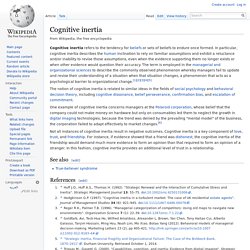
In particular, cognitive inertia describes the human inclination to rely on familiar assumptions and exhibit a reluctance and/or inability to revise those assumptions, even when the evidence supporting them no longer exists or when other evidence would question their accuracy. The term is employed in the managerial and organizational sciences to describe the commonly observed phenomenon whereby managers fail to update and revise their understanding of a situation when that situation changes, a phenomenon that acts as a psychological barrier to organizational change.[1][2][3][4][5] Doublethink. Origin and concepts[edit] According to the novel, doublethink is: Orwell explains that the Party could not protect its iron power without degrading its people with constant propaganda.
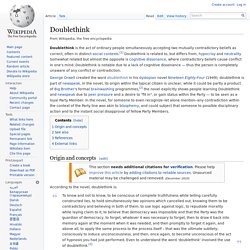
Experience sampling method. In psychometrics, the experience sampling method is a research methodology that asks participants to stop at certain times and make notes of their experience in real time. The point is for them to record temporal things like feelings while in the moment (right then, not later; right there, not elsewhere).
Personal Integrity. Mind and Life XXV Webcast. Envisioning the Future of Mind and Life. Wisdom 2.0 - Living with awareness, wisdom, and compassion - Home. Center for Investigating Healthy Minds. Thriving. A Biological Basis for the Unconscious? What's the Big Idea? Today, the question of how people make decisions is an animated and essential one, capturing the attention of everyone from neuroscientists to lawyers to artists.
In 1956, there was one person in all of New York known for his work on the brain: Harry Grundfest. An aspiring psychiatrist who was born in Austria in the 1930's, Eric Kandel took an elective in brain science during medical school and found himself studying alongside Grudfest at Columbia University. “What is it you want to study?” (3) Empathy. (3) Sympathy. Compassion. Mirror neurons. Mentalization.
Psych Central Blogs.